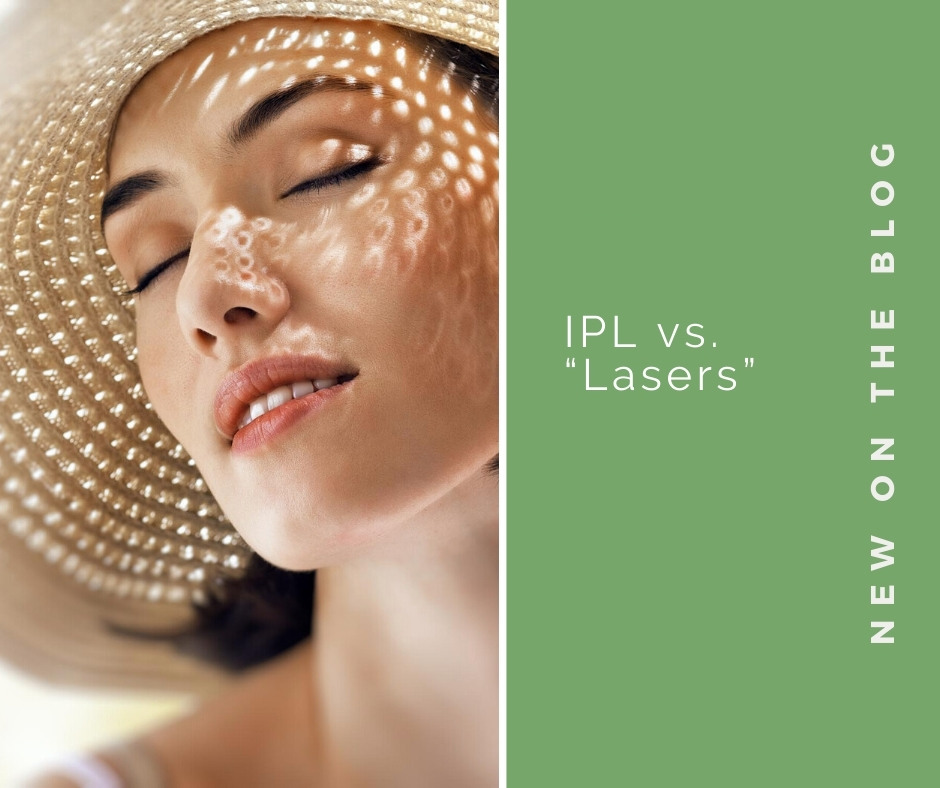
20 Jun IPL vs. “Lasers”
Not all lasers today are actually lasers. Intense pulsed light therapy, also known as IPL or a photofacial, is one of the most popular treatments at Parson Skin Center and actually isn’t a laser at all. Instead, it’s just what it sounds like: intense pulses of light that can undo sun damage, improving color and texture. Although IPL can technically be used just about anywhere, it is most commonly suggested for the face, neck, chest, and hands. IPL is typically one of the first recommendations for those struggling with brown spots, red spots, and splotchy skin.
Instead of a more aggressive laser that can cause damage and require downtime, IPL heats up the target area to remove unwanted pigments. More than one wavelength is directed to the site at a time (unlike lasers) in a pulsing pattern to ensure a gentle treatment that still packs a powerful punch. An IPL treatment does not damage the nearby healthy skin, so recovery is relatively quick and painless. However, skin can look red right after your treatment and this can persist anywhere from 1 – 4 days depending on the treatment site, your skin color and sensitivity, and how many areas you treat during your appointment.
Is IPL for You?
IPL can treat a wide variety of common skin conditions including birth marks, liver/age spots, all types of hyperpigmentation, fine lines, wrinkles, freckles, broken blood vessels, rosacea redness, scars, spider veins, and it’s even a popular option for laser hair reduction. There are few contraindications for IPL, like some clients with certain skin conditions, those taking certain medications, and women who are pregnant; these patients should avoid IPL until their current condition changes. To see if this applies to you, schedule a consultation for IPL prior to booking your procedure.
If you use retinoid cream, you will need to stop treatment for some time before you qualify for IPL. More serious skin concerns like keloid and severe scarring will not get optimal benefits from IPL and are better suited to other laser or energy-based technologies. IPL can be used on many skin tones, but those with a lot of melanin might be better matched to another technology in order to avoid the risk of hypopigmentation. However, in the world of lasers, IPL remains one of the most in-demand options because it can do so much in just a few sessions. For example, those treating redness see a reduction of 50 – 76 percent on average after just 1 – 3 IPL treatments. In many cases, the redness totally dissipates. This is also true of rosacea patients, a harmless condition which has no known cure, but you can manage it with routine treatments.
Getting Into the IPL Regimen
On average, clients see a reduction of 70 percent of sun damage (redness and brown spots) after their recommended IPL sessions. For those treating acne, an average of six sessions is recommended before you start seeing a significant difference. And if you’re interested in IPL for hair reduction, those with fairer skin and darker hair achieve the best results with IPL. Before booking an IPL session, regardless of your goals, it’s important to avoid direct sun exposure for four weeks (and plan to continue to avoid such exposure for another two weeks).
During your treatment, a gel is applied to the skin and you’ll be given special glasses to safeguard your eyes. The handheld IPL device is applied directly to the skin. Most appointments last around 30 minutes, though treatment of larger areas can require over one hour. The vast majority of people can withstand the light pulses fine and often compare it to a gentle stinging or snapping sensation. For those with sensitive skin or treating sensitive areas, a topical numbing cream may be applied.
What to Expect with IPL
Immediately after the treatment, it can feel like you have a sunburn for a few hours. Ice packs can help with this. You can help speed up recovery by using a recommended medical-grade moisturizer, avoiding sunlight, and using a gentle medical-grade cleanser to wash the treated area. You can also optimize IPL results by pairing it with other procedures like microdermabrasion, chemical peels, and microneedling.
Ready to find out if IPL is for you or to see which laser (or lasers) are your best match? Get in touch with Parson Skin Center by calling the office or filling out the online form today.
